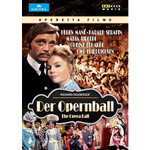|
Back
03/28/2017
Richard Heuberger: Der Opernball
Helen Mané (Angèle), Harald Serafin (Paul), Maria Tiboldi (Marguérite), Maurice Besançon (Georges), Tatiana Iwanow (Palmira), Heinz Erhardt (Caesare), Christiane Schröder (Hortense), Uwe Friedrichsen (Henri), Beate Hasenau (Feodora), Martin Jente (Philipp), Benno Hoffmann (Jean), Toxi (Claudine), Chesterina Sim Zecha (Brigitte), Ernst Stankovski (Toulouse-Lautrec), Karin Heske (Model), Symphony Orchestra Kurt Graunke, Munich, Willy Mattes (Musical Director), Eugen York (Director), Reinhold Brandes, Eugen York (TV Adaptation), Rudolf Kühn (Musical Arrangement), Klaus Gotthardt (Production Manager), Günter Haase, Gerd Neubelt (Camera), Gerd Krauss (Set Designer), Helga Pinnow (Costume Designer), William Milié (Choreographer), Joachim Augustin (Sound Supervisor)
A production of Accord Film GMBH © 1970 Unitel – 100’
Arthaus Musik Cat #: NTSC 109307 – Sound PCM Stereo – Format 4:3 – Region 0 – Booklet in German – Subtitles in German, English and French

   
Best known as a composer in the field of operetta, Richard Heuberger’s most notable work comes to life in this splendidly delightful and rollicking work featuring a cast of very talented singers and dancers. Premiering on January 8, 1898 Der Opernball continues to favor its Viennese patrons despite its relative obscurity across The Pond.
The plot is narrated through Toulouse-Lautrec (Ernst Stankovski) as he paints his model (Karin Heske) on canvas: a team of two wives (Helen Mané and Maria Tiboldi) who set out to test the fidelity of their husbands (Harald Serafin and Maurice Besançon) during Paris’ opera ball. Since the operetta was produced in 1970, studios at that time fused pre-recorded singing with acting. Though the technique disjoints with ultimate cinematic quality, the artistry, nonetheless, compensates by way of dance, sets and costuming to create an “over the top” experience.
Reinhold Brandes’ and Eugen York’s clever camera shots memorably sync to poignant beats found inside Heuberger’s “Overture,” a continuous melody weaving its way through the film. We find choreography by William Milié to be incisively brilliant and cleanly sharp while several of the numbers establish the effect of La Belle Epoque using Helga Pinnow’s lavish attire including can-can dresses and aristocratic outfits. Gerd Krauss’ sets, though rather two-dimensional in nature, keenly evince an artistic design in vogue of Toulouse-Lautrec paintings to add continuity and colorful measures.
Despite lengthy dialogues, the singing in between has many memorable moments. In particular is Heuberger’s seductive waltz, “Gehen wir ins Chambre séparée.” The acting is as frothy as the bubbly music. Stylistically, Eugen York’s techniques conjure the same imagery as found within George Cukor’s My Fair Lady.
Operetta fans will find this Arthaus Musik recording a great addition to their shelf.
Christie Grimstad
|